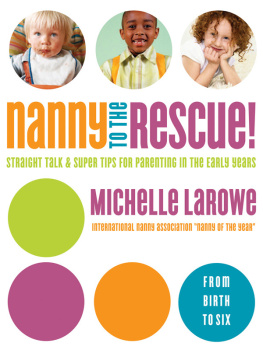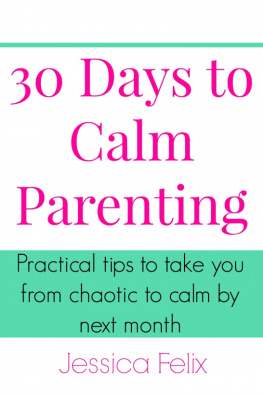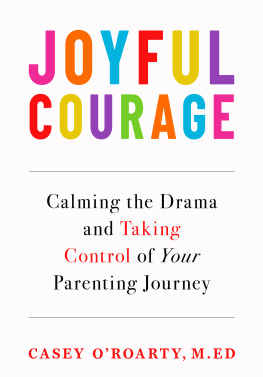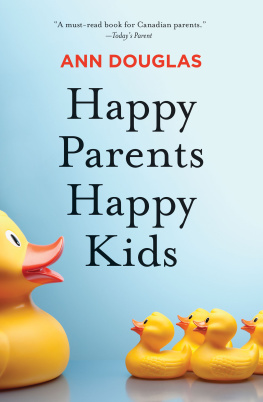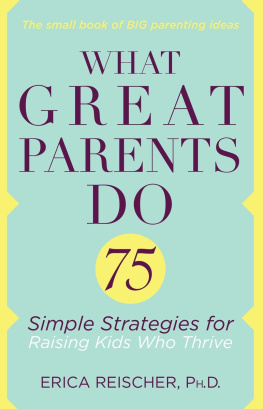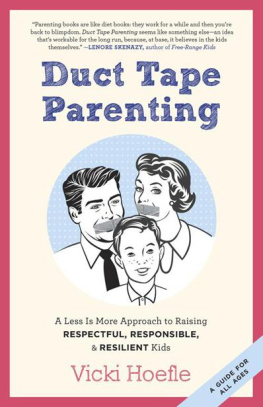First published by Bibliomotion, Inc.
39 Harvard Street
Brookline, MA 02445
Tel: 617-934-2427
www.bibliomotion.com
Copyright 2015 by Vicki Hoefle
All rights reserved. No part of this publication may be reproduced in any manner whatsoever without written permission from the publisher, except in the case of brief quotations embodied in critical articles or reviews.
Library of Congress Cataloging-in-Publication Data
Hoefle, Vicki.
The straight talk on parenting : a no-nonsense approach on how to grow a grown-up / Vicki Hoefle.
pages cm
Includes bibliographical references and index.
ISBN 978-1-62956-049-6 (paperback) ISBN 978-1-62956-050-2 (ebook) ISBN 978-1-62956-051-9 (enhanced ebook)
1. Parenting.2. Child rearing. 3. Parent and child. I. Title.
HQ755.8.H5887 2015
306.874dc23
2014045848
When Vicki asked me to write this foreword, I was deeply honored and completely horrified. Honored because, when I met Vicki a couple of years ago, I became instantly smitten with her. Smart as hell, funny, and compassionate, Vicki immediately became someone I admired. But I was horrified because now I have to write about someone I think is great. So, I picked up a book sitting on my bedside table (a parenting book, of course) and started to read the foreword. It is written by the Dalai Lama. Yes, that Dalai Lama. I took it as a sign. Consider this foreword to be just like one the Dalai Lama would write. Me, but more like him.
In any case, I presume you have picked up this book because you want to learn more about parenting. You are in some sort of pickle with your kids and you are tired. Tired of the fights and the whining. Tired of the back talk and the laziness. Tired. When I met Vicki, I was (and still am) just like you: tired of repeating my childrens names, tired of the nagging, and tired of the reminding.
I learned of Duct Tape Parenting from an article and thought, This is a little nuts I am absolutely doing this. For five days, I put a Phineas and Ferb Band-Aid over my mouth during my morning routine of getting the kids (ages two, five, and eight) up, fed, and out the door. I took pictures and wrote a blog about it, because of course it worked. Just as Vicki suggests, when we as parents take responsibility for our own behavior and, in my case, just shut up, we see that our children can and want to be useful, sweet, funny, caring, and good. And this is why you are going to read the second of Vickis books, The Straight Talk on Parenting: A No-Nonsense Approach on How to Grow a Grown-Up.
You can read, quite literally, a million parenting books about theory and tips and tricks, etc., but this book is different because it is sustained by the belief that children are good, and that there are ways we can grow our families that will help us, the parents, appreciate this fact. Not only does Vicki already know this, but her book is chock-full of stories of how the model she uses looks in real familiesfamilies she has helped and who did not sugarcoat their lives for us. Because, in the end, improving our parenting is not about reading one book, but rather practicing over our lifetime. Ask Vicki about her own children and she will gleefully tell you both how they are growing and how she is growing as a mother. The journey isnt over! We all know this, and this book will help remind you of that fact.
So, congratulations on picking up this book. You have done yourself and your children a great service. Vickis kindness, experience, and love for families shine through on every page; I know you will love her as much as I do.
Meghan Leahy
positivelyparenting.com/about-me/
washingtonpost.com/people/meghan-leahy
In my first book, Duct Tape Parenting, I introduce parents to the concept of a less-is-more approach to raising respectful, responsible, and resilient kids. This approach ensures that parents provide opportunities for their children to participate more fully in their own lives and in the life of their family. It encourages parents to allow children to make more choices concerning daily life, so they feel a strong sense of belonging and feel valued as contributing members of their family. This less-is-more approach invites parents to show greater trust in their children and to allow them to make mistakes, take risks, and learn to navigate the real world with confidence and enthusiasm.
When I was a young mother I knew two things: first, I was not going to give my sticky-fingered toddler free rein over my home. Second, I knew that it was my responsibility to create an environment that provided plenty of practice navigating lifenot just the fun stuff but the messy side as well. I knew it was my job to train my children to become resilient people who could handle whatever life threw at them.
In order to stay balanced and juggle my childrens needs with my own, I created a visual to keep me focused. At first I pictured a mother standing directly in front of her children, paving the way and saving the day. I knew I did not want to be that mother. I wanted to be within reach but not in the way. So I envisioned this mother taking one step to the right and half a step back. That was the mother I wanted to beout of direct view, but not totally out of sight. In this position, I was close enough to watch what the kids were doing without intruding. Id be close enough to reach out and remove them from harms way if necessary. Its from this position that I have made nearly all my parenting decisions for more than twenty years. It was a perfect balance of being involved without taking over, being active without being controlling, and demonstrating trust while including a healthy dose of caution.
When I consider our role as parents, I think about establishing an approach that supports our children as they develop healthy relationships and as they become more independent and self-reliant. This approach must also afford our kids the opportunity to practice self, social, and life skills and strengthen their ability to rebound from difficult situations with a mix of grit and resilience.
In addition to defining an approach to parenting that supports our values, preferences, and temperaments, we as parents are charged with the responsibility of sending emotionally healthy human beings into the world with a set of character traits and attributes that ensures they will become contributing members of society and thoughtful leaders, and are able to create satisfying and fulfilling lives for themselves.
In my twenty-five years working with families, I have discovered that the long-term goal of raising a healthy human being is often buried under the stress and daily grind of raising young children. Most mothers and fathers who seek out a parenting class or a parent coach to work with are looking for strategies and solutions to help them deal with an immediate challenge they are facing with one or more of their children.
In my own work with parents I cant help but encourage them to consider the bigger picture. I suggest thatalthough we will come up with strategies that address pesky behavior; create healthy routines for getting out of the house or to bed on time; investigate systems for organizing rooms, sports gear, and homework; develop communication styles that are respectful to everyone in the home and that maintain an attitude of cooperation and collaborationwe also need to consider the fact that we are raising future adults.
I know, as a mother and a parenting expert, that when a parent focuses on the long-term objective of raising a healthy child who will one day be an adult, many of the stressors of day-to-day life fade away. To help parents make the switch from the immediate to the long term, I ask them to participate in a simple exercise: Lets make a list of all the character traits and attributes you hope your adult children will embody at the age of twenty-five. Parents are quick to create a long list of adjectives that include kind, responsible, respectful, hardworking, self-disciplined, happy, independent, and compassionate.


